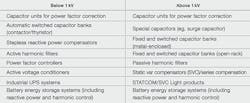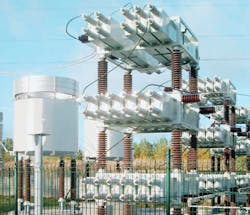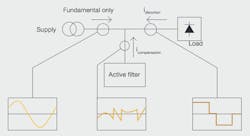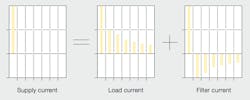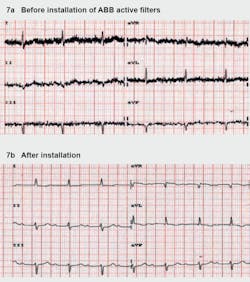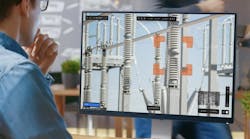An ideal electrical AC supply system voltage is sinusoidal with a constant amplitude and frequency. An ideal AC load current is sinusoidal at the same frequency and in phase with the voltage. Such a system is the most stable, will run with minimal losses for a given requirement and can be said to have optimal power quality. In real life, many factors cause deviation from the ideal situation and the power quality deteriorates. Consequently, installation lifetime and running efficiency decreases, and running cost increases. If production is stopped unexpectedly, eg, due to poor power quality, major costs are incurred [1]. The benefits of good power quality are manifold ➔ 1.
Poor power quality has many sources:
- Reactive power, which causes line losses and voltage variations, and loads the supply system unnecessarily.
- Harmonic pollution, which causes extra stress on the networks, potentially leading to equipment malfunction, and makes installations run less efficiently.
- Load imbalance, (eg, in single-phase railway applications or office buildings). The unbalanced loads may result in excessive voltage imbalance, causing stress on other loads connected to the same network and leading to an increase of neutral current and neutral-to-earth voltage build-up in four-wire systems.
- Voltage variations (eg, dips, sags, swells) that can lead to load malfunction and, when repetitive, can lead to flicker problems. Voltage variations can be caused by load current variations, or by external factors such as transmission or distribution line incidents (eg, lightning strikes).
In order to maintain good power quality on the network, utilities invest in power quality equipment themselves and/or put a suitable tariff/penalty structure in place aimed at limiting the effects caused by network users. Network users install power quality equipment to comply with regulations and/or to obtain optimal system efficiency.
World leader in power quality
ABB delivers a complete portfolio of power quality products and know-how in the low-voltage (LV), medium-voltage (MV) and high-voltage (HV) areas with a focus on efficient and environmentally friendly power transport to, and power usage by, resources connected to the grid ➔ 2. ABB has been driving development in the field of power quality for over 70 years.
Reactive power compensation
The inductive series impedance of overhead lines results in reactive power consumption. This increases with the square of the current, causing a voltage drop and, consequently, a reduction in the capacity of the line to transmit power. To limit these effects, reactive power compensation equipment, such as shunt capacitor banks, is usually installed. The capacitor banks protect against adverse effects of voltage variations by maintaining a sufficiently high voltage level, thus contributing to the security and reliability of the grid. In addition, the compensation results in reduced system losses.
The higher its voltage, the greater the transmission capacity of the grid. The use of shunt capacitor compensation permits an increase in the active power that can be transmitted, thereby reducing the risk of voltage collapse phenomena. ABB's capacitor banks are used by many transmission and distribution operators.
In addition to capacitors for reactive power, ABB is at the forefront in the development of dry capacitor technology for DC applications ➔ 3.
|
3 Dry ABB capacitors for HVDC Light and SVC Light applications ABB has always been at the forefront of dry capacitor technology. After pioneering it for LV AC applications many years ago, ABB mastered and perfected dry capacitor technology to produce capacitors for high-voltage DC (HVDC) applications. ABB dry capacitors are substantially smaller than their conventional equivalents, making them ideal for situations that require high energy density – in HVDC Light and SVC Light applications, for instance. At the heart of these applications sits a voltage source converter (VSC) where the capacitor acts as the voltage/energy source. The higher the converter powers become, the higher the stored energy capability has to be. The latest converter topologies also require higher current densities. In addition to their compactness and higher power density capability, ABB's dry capacitors for DC applications have many more advantages such as self-healing, superior end-of-life performance and low inductance, making them extremely suitable for very demanding applications. |
Boosting efficiency in Bangladesh's grid
The Power Grid Company of Bangladesh (PGCB) selected ABB's HV open-rack capacitor bank to improve the performance of its 132 kV transmission grid, parts of which were suffering losses because of voltage drops and poor power quality.
The new reactive power compensation equipment was installed in the eight PGCB substations where losses were greatest and power flows most critical.
After installation, the power factor increased from 0.88 to 0.98, a significant achievement. The voltage rose by 3 to 5 kV compared with the initial situation. Raising the voltage of the system reduced the losses and improved the amount of active power that could be delivered to the end users.
The combined improvements in power factor and voltage allowed the equivalent of 34 MW of extra power to be brought into the grid, without needing to build any additional generation capacity. The ability to deliver this additional power has significantly improved PGCB's revenues.
Overall, the project had a payback time of 18 months. The cost was a fraction of the capital that would have been required to build an equivalent conventional fossil fuel power plant and an additional transmission line. Also, because the ABB system recovers lost capability rather than generating new additional power, there are no significant continuous operating costs and no extra greenhouse gas emissions.
In addition to the open-rack models, ABB offer a complete range of metal-enclosed capacitor banks (MECBs) for customers who have limited footprint, or who want full integration with a high degree of embedded protection. These banks can be installed inside or outside and are typically used in industrial applications or distribution utility applications, eg, for the compensation of grids or wind farms.
Improving power quality actively
The increasing prevalence of nonlinear loads in all types of industrial and commercial applications has resulted in the introduction of potentially harmful levels of current harmonics into the power network. Historically, passive filters have been, and are still being, proposed to mitigate harmonic pollution ➔ 4. In LV installations, these solutions are much less applicable, eg, due to overload risk where load patterns are dynamic.
ABB modular active power quality filters (PQFs) avoid the problems of passive filters by using power electronics hardware that continuously monitors current harmonics in real time and cancels them out by injecting currents of exactly the opposite phase. The feeding transformer then sees a clean sine wave – the optimal supply current waveform ➔ 5.
For best performance throughout the high filter bandwidth, two key control aspects of the ABB active filters are:
- Use of a genuine closed-loop control for optimal filtering performance.
- A frequency domain approach to the processing and control of the polluted current allowing the customer to target the pollution in an optimal way ➔ 6.
In addition to active harmonic filtering, ABB active filters can also:
- Perform stepless reactive power compensation of inductive and capacitive loads – useful/required in modern buildings with a lot of computing equipment.
- Perform load balancing. This enables neutral systems to be offloaded and ensures that neutral-to-earth voltages are kept to minimal levels, thus restoring installation safety and increasing installation reliability.
ABB active filters suppress ECG interference
Harmonic-producing hospital loads introduced electromagnetic interference severe enough to disrupt electrocardiograph (ECG) monitoring and recordings in the new emergency department at the Royal Melbourne Hospital in Australia. As a result, the new ECG facility could not be used.
Investigations involving ABB revealed that the source of the interference was harmonic currents flowing in the mains cable. This interference was suppressed by ABB active filter technology and the ECG equipment could then be successfully utilized [2] ➔ 7.
ABB was a pioneer in power quality technology and, today, offers extensive experience as well as a portfolio of products to help customers combat the increasing power quality challenges they face in all voltage categories.
Kurt Schipman
ABB Power Products, High Voltage Products
Jumet, Belgium
[email protected]
--------------------------------
References
[1] European Copper Institute, "European Power Quality Survey," 2002
[2] W.J. Davie et al., "ECG interference suppressed using a harmonic generator," Technical Paper, Australian Physical & Engineering Sciences in Medicine, vol. 32, no. 3, pp. 159–64, Sep. 2009.


